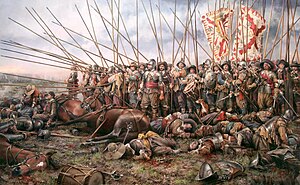
Back Batalla de Rocroi AN معركة روكرو Arabic رکروا دؤیوشو AZB Битка при Рокроа Bulgarian Emgann Rocroi Breton Batalla de Rocroi Catalan Bitva u Rocroi Czech Schlacht bei Rocroi German Μάχη του Ροκρουά Greek Battle of Rocroi English
| Batalla de Rocroi | ||||
|---|---|---|---|---|
| Parte de guerra de los Treinta Años | ||||
 Rocroi, el último tercio (2011), por Augusto Ferrer-Dalmau. | ||||
| Fecha | 19 de mayo de 1643 | |||
| Lugar | Rocroi (Ardenas), Francia | |||
| Coordenadas | 49°55′10″N 4°31′40″E / 49.919444444444, 4.5277777777778 | |||
| Resultado | Victoria francesa | |||
| Beligerantes | ||||
|
| ||||
| Comandantes | ||||
|
| ||||
| Fuerzas en combate | ||||
| ||||
| Bajas | ||||
| ||||
La batalla de Rocroi o Rocroy aconteció el 19 de mayo de 1643 entre el ejército francés al mando del joven Luis II de Borbón-Condé, por aquel entonces Duque de Enghien y de 21 años de edad, más tarde príncipe de Condé, y el ejército español a las órdenes del portugués Francisco de Melo, capitán general de los tercios de Flandes. El enfrentamiento, que comenzó antes de amanecer, duró cerca de seis horas, concluyendo con victoria francesa.
- ↑ a b The Cambridge modern history. Escrito con la colaboración de George Walter Prothero, Stanley Leathes, Sir Adolphus William Ward, John Emerich Edward Dalberg. CUP Archive, 1934, pp. 594:
the Spaniards numbering between 12,000 and 8,000, including five tercios of the redoubtable Spanish infantry; the French inferior by some 3,000-4,000 men, the proportions of cavalry and infantry being similar in the two armies.
- ↑ a b John Childs, Warfare in the Seventeenth Century. p. 74
- ↑ Las Grandes Guerras del Milenio. La Guerra de los Treinta Años. Tomo II. Editor: Telmo Meléndez, editorial Ercilla (2001), Santiago de Chile, pp. 138.
Después de diversas campañas, en 1643 un ejército español al mando de Francisco de Melo sitió la ciudad de Rocroi, cercana a la frontera holandesa. Su propósito era atraer a los franceses y derrotarlos en el campo de batalla con sus formidables tercios. Contaba con 27.000 hombres y 28 cañones.(...)Al término de la batalla, los españoles contaban 10.000 bajas, incluyendo 13 prisioneros.
- ↑ The Battle 100: The Stories Behind History's Most Influential Battles. Michael Lee Lanning. Sourcebooks, Inc., 2005, pp. 318.
At the end of the day more than 8,000 of Melo's soldiers, mostly infantrymen, were dead. Another 7,000 were taken prisioner. French losses totaled 4,000 dead.
- ↑ The Battle 100: The Stories Behind History's Most Influential Battles. Michael Lee Lanning. Sourcebooks, Inc., 2005, pp. 318.
At the end of the day more than 8,000 of Melo's soldiers, mostly infantrymen, were dead. Another 7,000 were taken prisioner. French losses totaled 6,000 dead.
- ↑ Quesada Fernando, Los mitos de Rocroi, nº 97 de La aventura de la Historia, Arlanza Ediciones, Madrid, noviembre de 2006